This post concludes (see Part 1) a brief survey of the final resting places of those men for whom dying provided a living.
 Undertakers are not the only people engaged in the business of death, of course. Consider people who establish and operate cemeteries. After Oakwood Cemetery opened in 1879, Fort Worth did not get a third public cemetery for another quarter-century (but see pocket cemeteries). In 1906 Flavious G. McPeak petitioned the city to open a cemetery on his farm east of the river and north of the “old Birdville road.” The land had been settled by pioneer Charles Biggers Daggett. Clip is from the December 18, 1906 Telegram.
Undertakers are not the only people engaged in the business of death, of course. Consider people who establish and operate cemeteries. After Oakwood Cemetery opened in 1879, Fort Worth did not get a third public cemetery for another quarter-century (but see pocket cemeteries). In 1906 Flavious G. McPeak petitioned the city to open a cemetery on his farm east of the river and north of the “old Birdville road.” The land had been settled by pioneer Charles Biggers Daggett. Clip is from the December 18, 1906 Telegram.
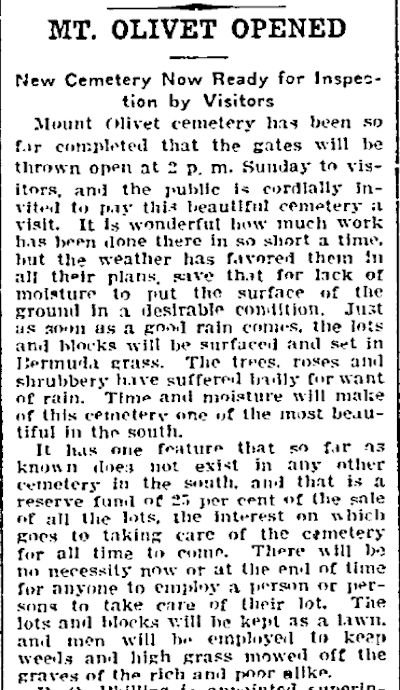 Mount Olivet Cemetery opened on April 7, 1907 offering something new: perpetual care. Clip is from the April 7, 1907 Telegram.
Mount Olivet Cemetery opened on April 7, 1907 offering something new: perpetual care. Clip is from the April 7, 1907 Telegram.
McPeak had modeled his cemetery after Mount Olivet Cemetery in Nashville. Cemeteries at the time had a problem with ghouls. Yes, grave robbers. They dug up freshly buried bodies and sold them to the medical community for study. The Nashville Mount Olivet came up with the idea of a receiving vault, in which bodies were securely stored until they had achieved a condition that would render them unattractive to grave robbers.
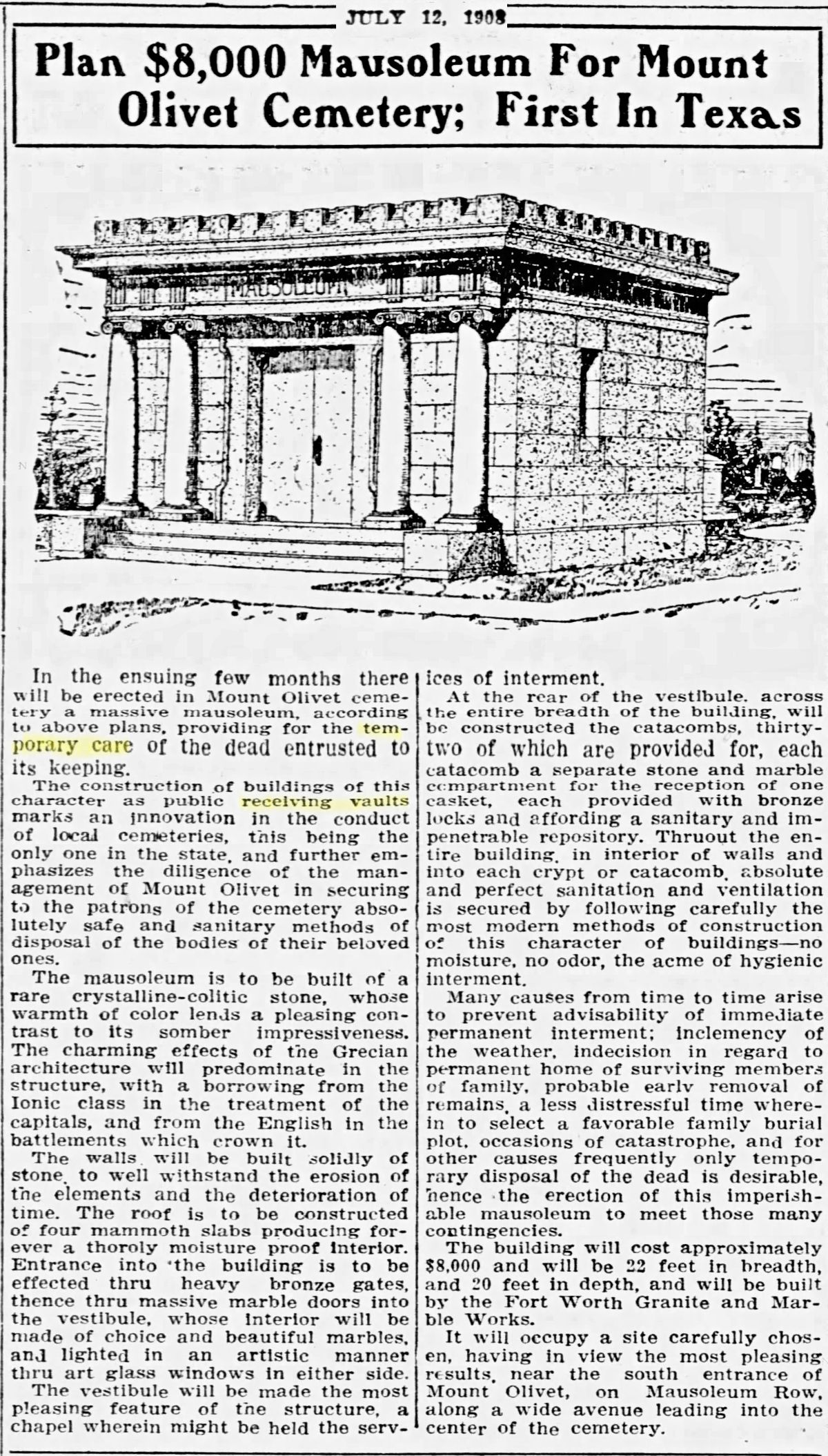
After two relatively successful years in business, in 1909 McPeak borrowed $6,000 ($163,000 today) from Farmers & Mechanics National Bank and installed at his Mount Olivet a receiving vault with thirty-two crypts. The vault was built on the west side of the cemetery. The ad says the “mausoleum”/receiving vault was for the “temporary care” of the dead.
Across town at Mount Olivet Cemetery in 1912 Flavious McPeak lost his cemetery to foreclosure. The directors of the bank, including William Bryce, William Capps, and John P. King, paid off McPeak’s debt in 1912 and took over Mount Olivet.
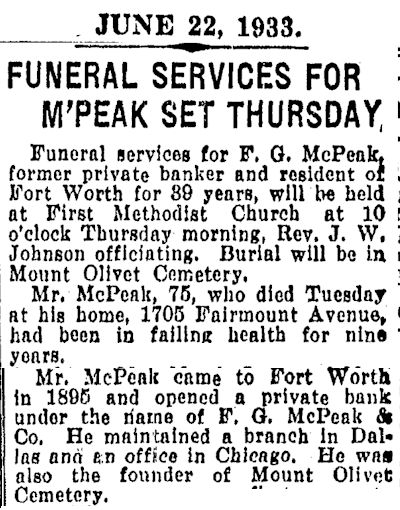 Flavious G. McPeak died in 1933.
Flavious G. McPeak died in 1933.
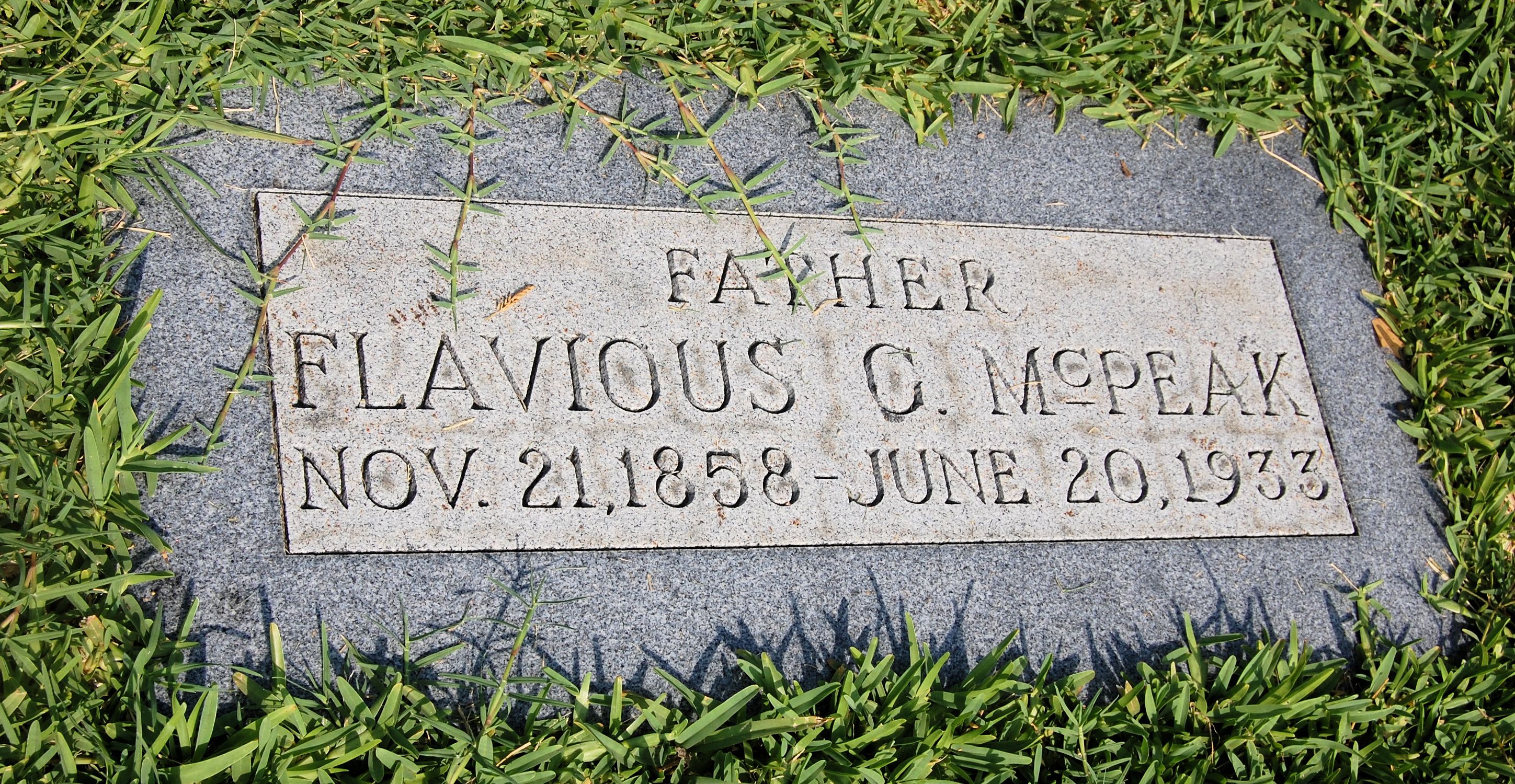 Flavious G. McPeak is buried in the cemetery he founded on land where he once lived.
Flavious G. McPeak is buried in the cemetery he founded on land where he once lived.
Like any city, Mount Olivet, a city of the dead with a population of eighty-one thousand, has a cross-section of residents, ranging from B. B. Paddock to Marshall Ratliff.
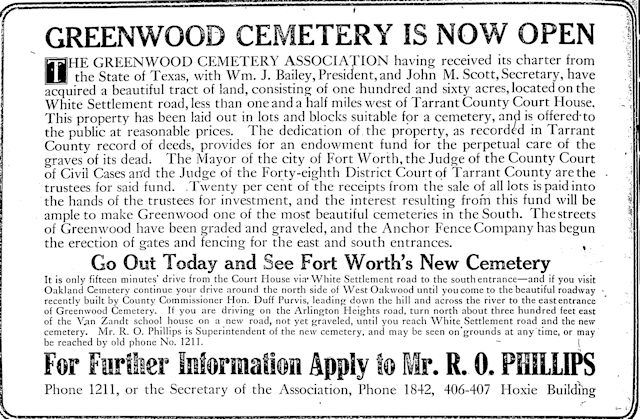 William J. Bailey, land developer and state senator, once owned two thousand acres on the near West Side. He founded Greenwood Cemetery—somewhat inadvertently—in 1909. Clip is from the March 28, 1909 Star-Telegram.
William J. Bailey, land developer and state senator, once owned two thousand acres on the near West Side. He founded Greenwood Cemetery—somewhat inadvertently—in 1909. Clip is from the March 28, 1909 Star-Telegram.
 William J. Bailey died in 1949 in his home across White Settlement Road from his cemetery.
William J. Bailey died in 1949 in his home across White Settlement Road from his cemetery.
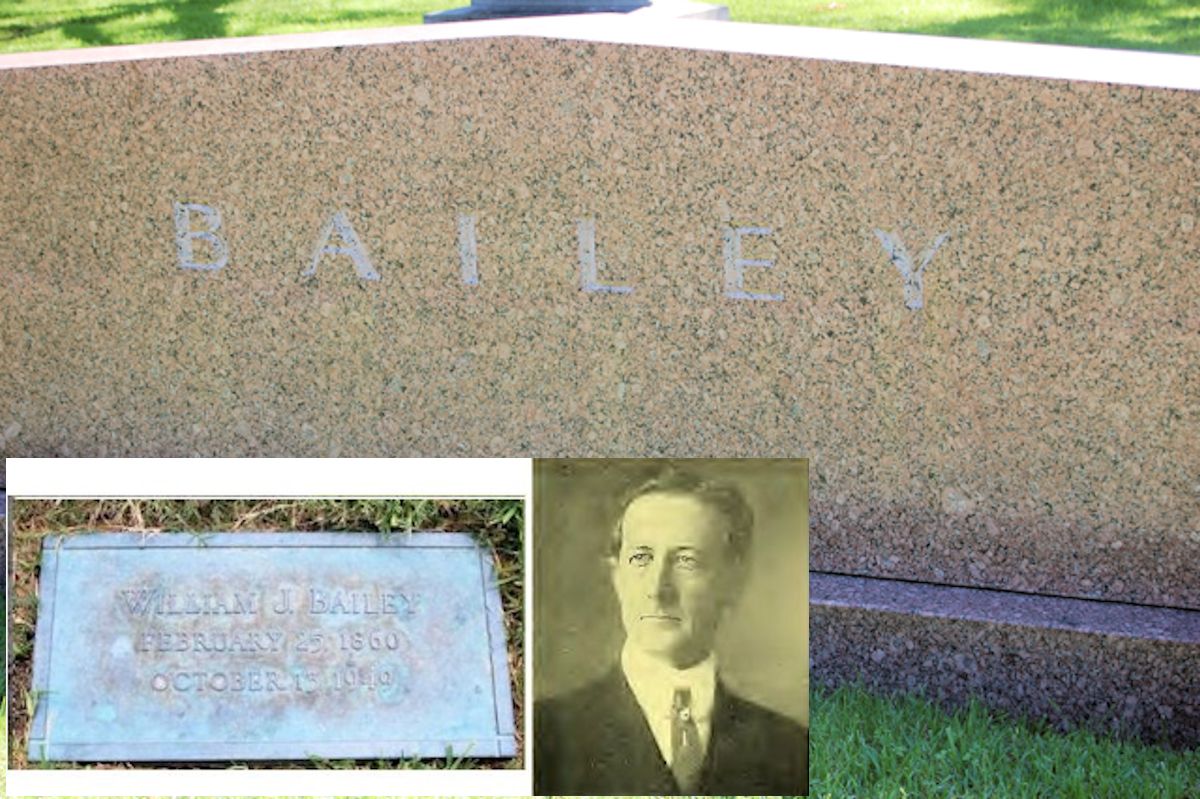 In 1917 William J. Bailey had bought Mount Olivet Cemetery. But he is buried in the cemetery he founded in 1909.
In 1917 William J. Bailey had bought Mount Olivet Cemetery. But he is buried in the cemetery he founded in 1909.
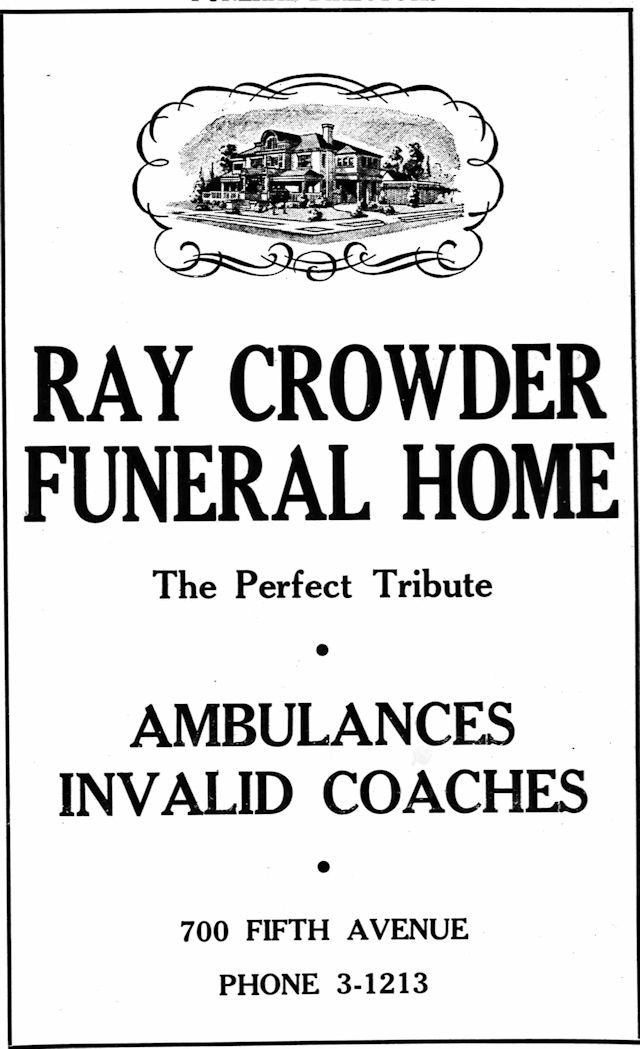 Ray Crowder operated a funeral home and ambulance service on 5th Avenue . . .
Ray Crowder operated a funeral home and ambulance service on 5th Avenue . . .
 and then on Hemphill Street in the 1908 Reeves-Walker house.
and then on Hemphill Street in the 1908 Reeves-Walker house.
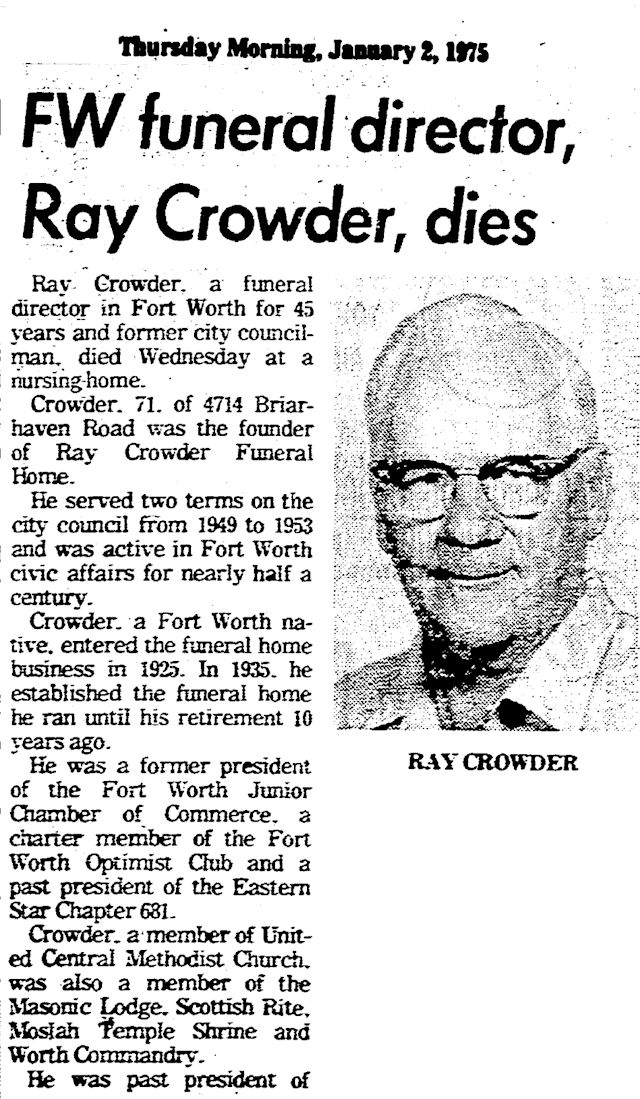 Ray Crowder died in 1975.
Ray Crowder died in 1975.
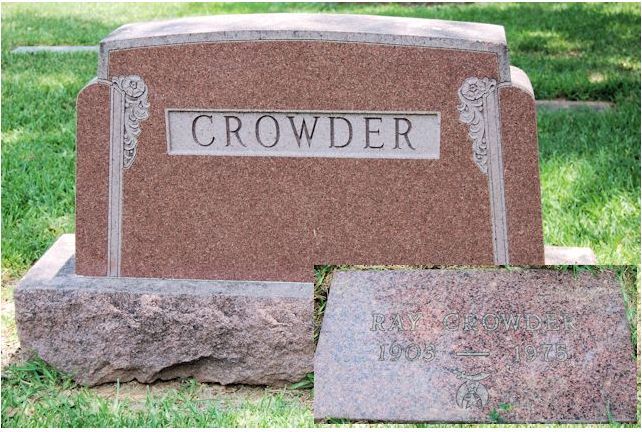 He is buried in Bailey’s Greenwood Cemetery.
He is buried in Bailey’s Greenwood Cemetery.
 James Nathan Baker in 1926 opened a “colored funeral home” south of the “downtown” of Fort Worth’s African-American community.
James Nathan Baker in 1926 opened a “colored funeral home” south of the “downtown” of Fort Worth’s African-American community.
 James Nathan Baker died in 1970. He is buried in New Trinity Cemetery (Peoples Burial Park), which he bought in 1947.
James Nathan Baker died in 1970. He is buried in New Trinity Cemetery (Peoples Burial Park), which he bought in 1947.
 Quincy Adams Harveson and embalmer Samuel D. Sloan opened Sloan & Harveson in 1911. In the 1920s that undertaking company evolved into Harveson & Cole as Grover Cleveland Cole joined Quincy Adams Harveson. In 1931 Sloan became manager of Fort Worth Undertaking Company, 10th and Lamar streets, after that company was bought by S. D. and Oliver Shannon (see Part 1). Harveson & Cole for thirty years beginning in 1927 was located on the ground floor of the Masonic lodge building (still standing) on Magnolia Avenue. Clips are from the 1916, 1941, and 1968 city directories.
Quincy Adams Harveson and embalmer Samuel D. Sloan opened Sloan & Harveson in 1911. In the 1920s that undertaking company evolved into Harveson & Cole as Grover Cleveland Cole joined Quincy Adams Harveson. In 1931 Sloan became manager of Fort Worth Undertaking Company, 10th and Lamar streets, after that company was bought by S. D. and Oliver Shannon (see Part 1). Harveson & Cole for thirty years beginning in 1927 was located on the ground floor of the Masonic lodge building (still standing) on Magnolia Avenue. Clips are from the 1916, 1941, and 1968 city directories.
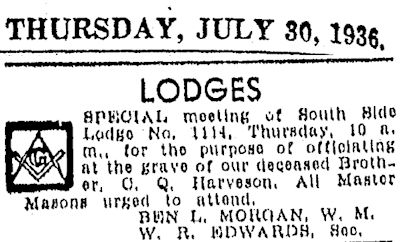 Quincy Adams Harveson died in 1936. Upon his death his fellow Masons met in their lodge building, which housed Harveson & Cole.
Quincy Adams Harveson died in 1936. Upon his death his fellow Masons met in their lodge building, which housed Harveson & Cole.
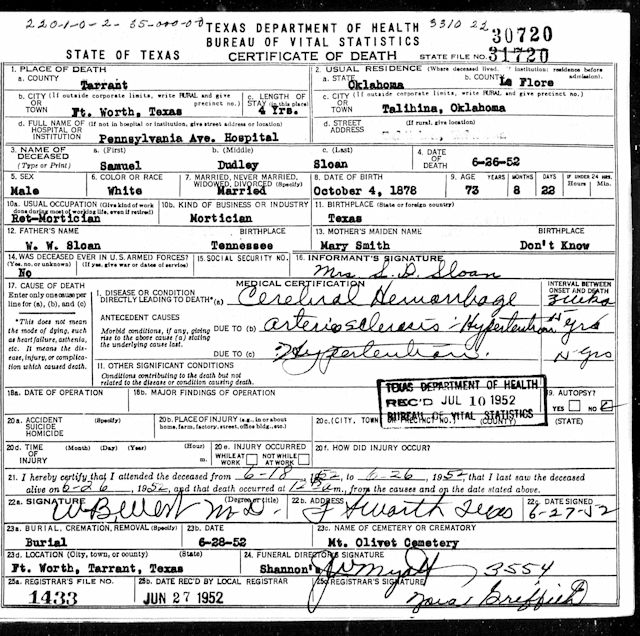 Samuel Dudley Sloan died in 1952.
Samuel Dudley Sloan died in 1952.
 He is buried in Mount Olivet Cemetery.
He is buried in Mount Olivet Cemetery.
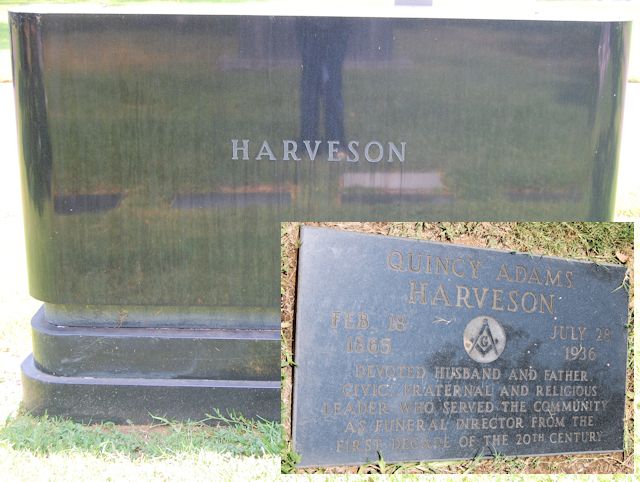 Quincy Adams Harveson is buried in Greenwood.
Quincy Adams Harveson is buried in Greenwood.

(Grover Cleveland Cole died at the home of relatives, not in a hospital.)
 Grover Cleveland Cole is buried in Greenwood.
Grover Cleveland Cole is buried in Greenwood.
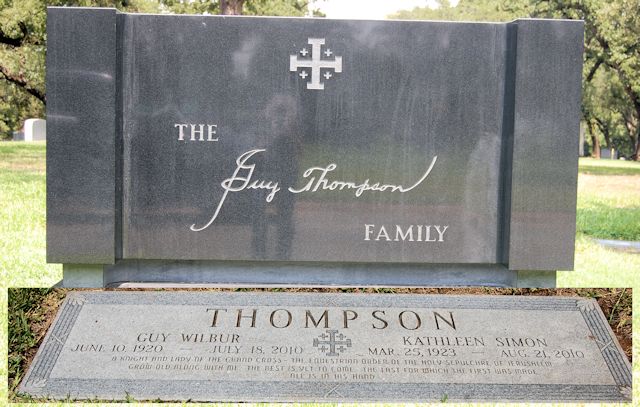 Guy Thompson joined Harveson & Cole in 1948. When Thompson died in 2010 at age ninety he was Fort Worth’s oldest working funeral director. During sixty years he buried more than twenty-five thousand people, including his parents, Amon Carter, and J. Frank Norris.
Guy Thompson joined Harveson & Cole in 1948. When Thompson died in 2010 at age ninety he was Fort Worth’s oldest working funeral director. During sixty years he buried more than twenty-five thousand people, including his parents, Amon Carter, and J. Frank Norris.
The business is now Thompson’s Harveson & Cole Funeral Home.
Guy Thompson is buried in Greenwood.
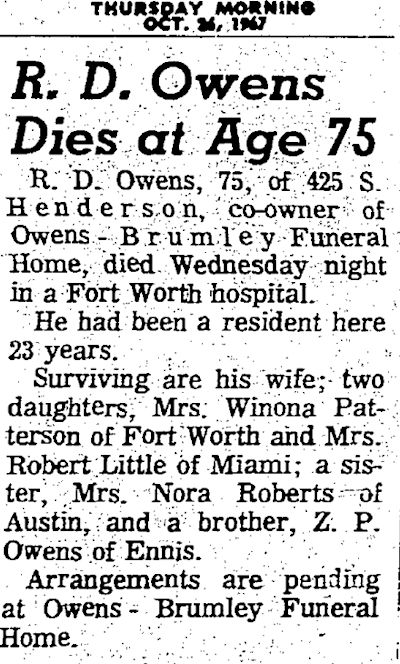 R. D. Owens (1892-1967) co-founded Owens & Brumley funeral home in 1922. As we have seen, funeral homes are often subject to mergers and are owned by several generations of one or more families. And so it is with Owens & Brumley (now Brown Owens & Brumley), which traces its beginning to George Gause.
R. D. Owens (1892-1967) co-founded Owens & Brumley funeral home in 1922. As we have seen, funeral homes are often subject to mergers and are owned by several generations of one or more families. And so it is with Owens & Brumley (now Brown Owens & Brumley), which traces its beginning to George Gause.
R. D. Owens is buried in Laurel Land.
 Another profession that is part of the business of death is that of monument maker (tombstones). The Cheek monument company has been in business since Fred Cheek founded it in 1928.
Another profession that is part of the business of death is that of monument maker (tombstones). The Cheek monument company has been in business since Fred Cheek founded it in 1928.
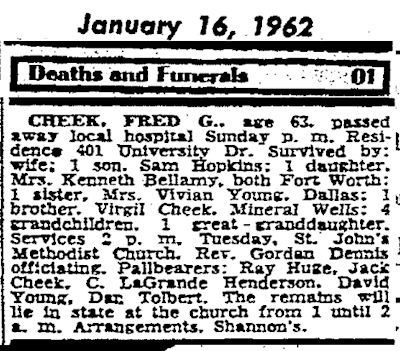 Fred Cheek died in 1962.
Fred Cheek died in 1962.

He is buried in Greenwood.
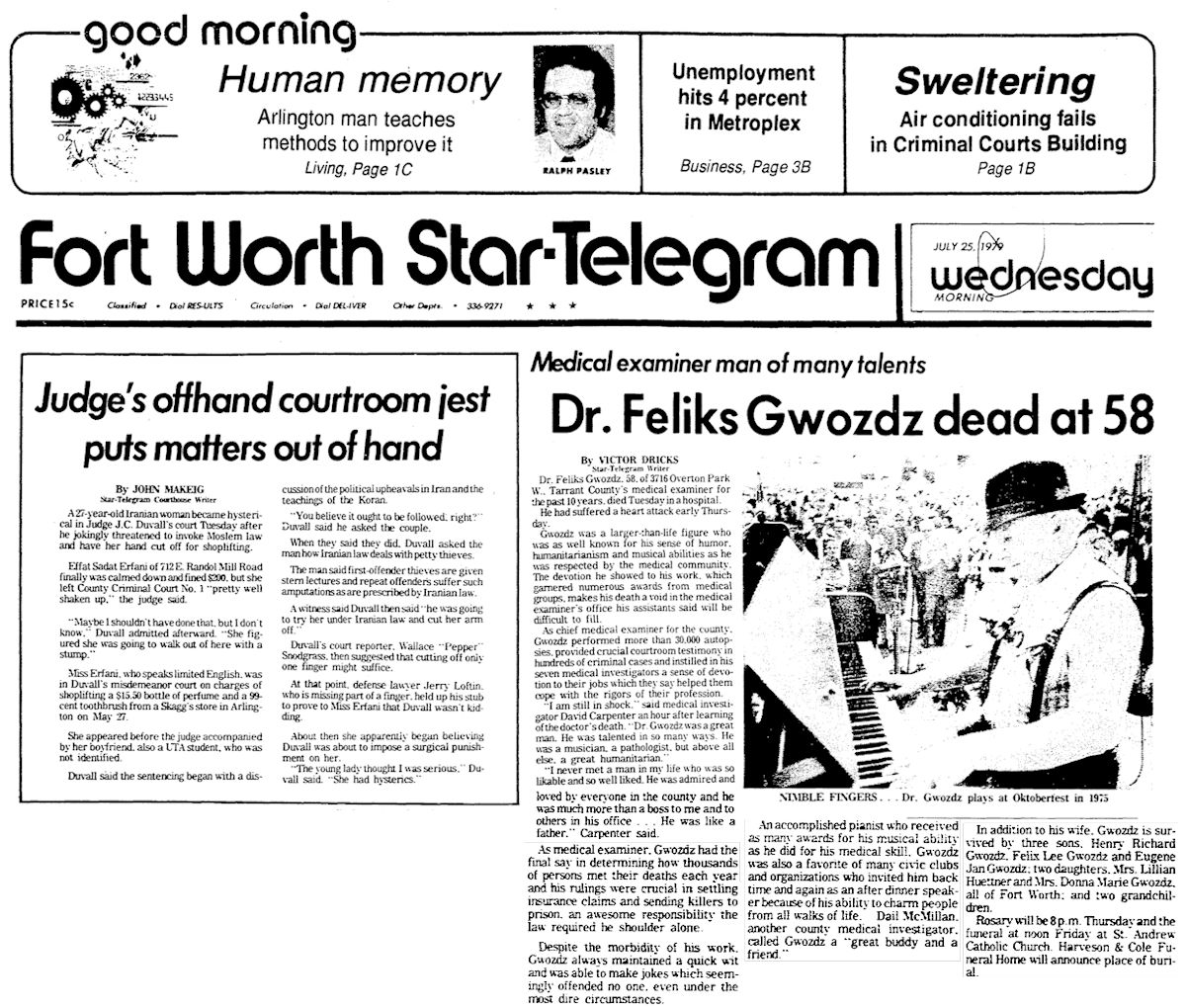 And then there is the medico-legal aspect of the business of death. Dr. Feliks Gwozdz for ten years was Tarrant County chief medical examiner, performing thirty thousand autopsies in both low-profile deaths and high-profile deaths (including those in the Cullen Davis murder case). Gwozdz, born in Poland, had been drafted into the Polish army in 1938, survived Nazi concentration camp Stalag XXI in Poland. After he was released with other POWs about 1939 he returned to Krakow and earned a living as a pianist. But in 1942 the Germans arrested him, and he again was sent to a concentration camp. When he was released from Dachau he weighed about eighty pounds. He came to the United States in 1951. He was Tarrant County deputy medical examiner from 1965 to 1969 and chief medical examiner from 1969 to his death in 1979. A man of music, he was choir director and organist at Fort Worth’s St. Andrew Catholic Church more than a quarter-century.
And then there is the medico-legal aspect of the business of death. Dr. Feliks Gwozdz for ten years was Tarrant County chief medical examiner, performing thirty thousand autopsies in both low-profile deaths and high-profile deaths (including those in the Cullen Davis murder case). Gwozdz, born in Poland, had been drafted into the Polish army in 1938, survived Nazi concentration camp Stalag XXI in Poland. After he was released with other POWs about 1939 he returned to Krakow and earned a living as a pianist. But in 1942 the Germans arrested him, and he again was sent to a concentration camp. When he was released from Dachau he weighed about eighty pounds. He came to the United States in 1951. He was Tarrant County deputy medical examiner from 1965 to 1969 and chief medical examiner from 1969 to his death in 1979. A man of music, he was choir director and organist at Fort Worth’s St. Andrew Catholic Church more than a quarter-century.
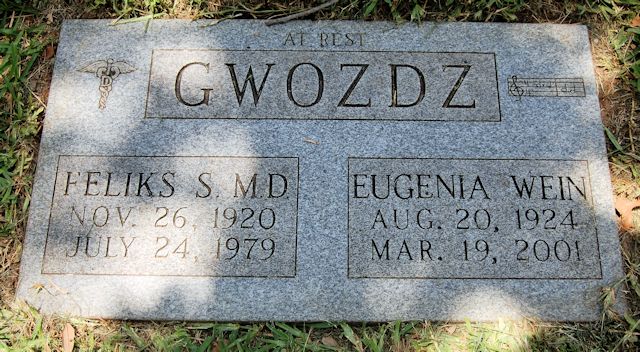 Dr. Gwozdz is buried in Greenwood. Note the caduceus and musical staff denoting his profession and his passion.
Dr. Gwozdz is buried in Greenwood. Note the caduceus and musical staff denoting his profession and his passion.
Son Eugene, himself a musician, said the notes on the staff are the first four notes of the motet “Oh, How Blessed,” which Dr. Gwozdz often performed with the St. Andrew Catholic Church choir.
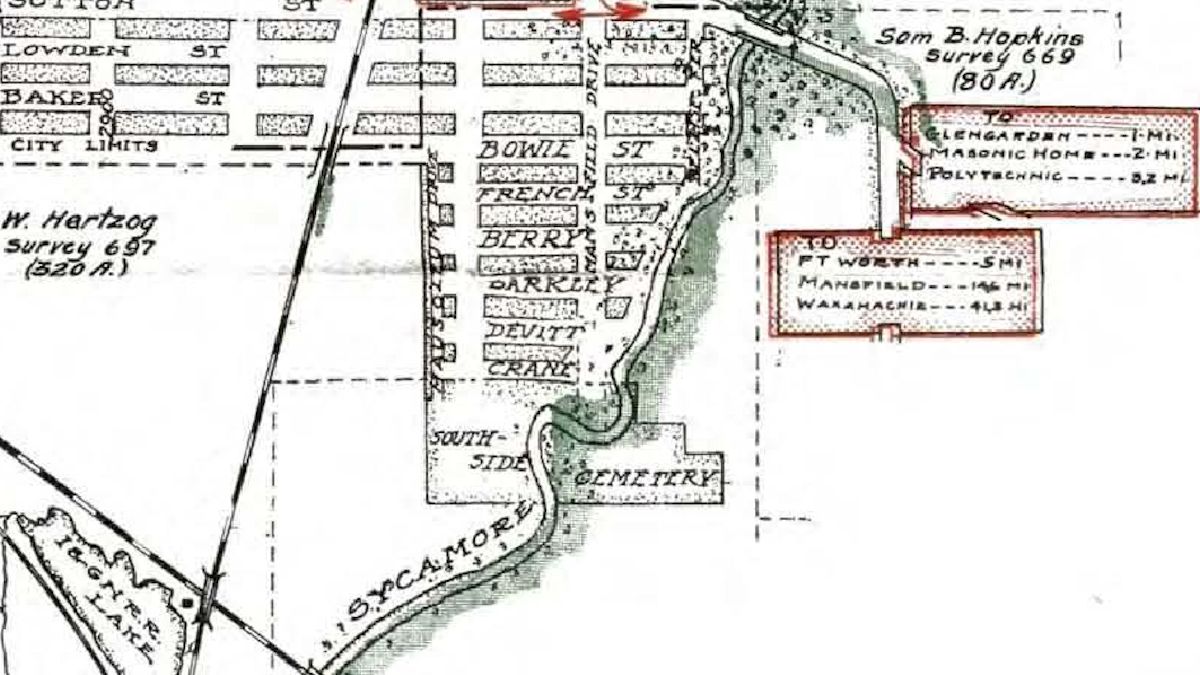 “And who,” you ask, squinting at the map above, “is buried in South Side Cemetery?” Hah! You can’t fool me. That’s a trick question. There is no South Side Cemetery. Never was. But this map from 1920 (from Pete Charlton’s “1000+ Lost Antique Maps of Texas & the Southwest on DVD-ROM”) shows, just northeast of Echo Lake, a large tract along Berry Street on both sides of Riverside Drive (then outside the city limits) labeled “South Side Cemetery.” The map shows a “Mausoleum Drive” on the western edge of the cemetery.
“And who,” you ask, squinting at the map above, “is buried in South Side Cemetery?” Hah! You can’t fool me. That’s a trick question. There is no South Side Cemetery. Never was. But this map from 1920 (from Pete Charlton’s “1000+ Lost Antique Maps of Texas & the Southwest on DVD-ROM”) shows, just northeast of Echo Lake, a large tract along Berry Street on both sides of Riverside Drive (then outside the city limits) labeled “South Side Cemetery.” The map shows a “Mausoleum Drive” on the western edge of the cemetery.
 This 1940 map (from Pete Charlton’s “1000+ Lost Antique Maps of Texas & the Southwest on DVD-ROM”) labels the land as “reserved” for a “South Side Cemetery.” But maps of 1939 and 1943 have no such designation, and I find no such cemetery or business listing in city directories. However, that area would later be home to Elliot Lake, Ward Plaza, Town Plaza, a tourist court, a municipal solid-waste facility, and a small amusement park where a monkey smoked cigarettes. And they are all dead.
This 1940 map (from Pete Charlton’s “1000+ Lost Antique Maps of Texas & the Southwest on DVD-ROM”) labels the land as “reserved” for a “South Side Cemetery.” But maps of 1939 and 1943 have no such designation, and I find no such cemetery or business listing in city directories. However, that area would later be home to Elliot Lake, Ward Plaza, Town Plaza, a tourist court, a municipal solid-waste facility, and a small amusement park where a monkey smoked cigarettes. And they are all dead.






McHaney, I went to OD wyatt HS Glad to meet someone kin to him
Great article love your page. Grew up over there. My Aunt Dad was OD Wyatt. My dad coached football at Paschal etc…
Thank you, Mr. McHaney.
I am interested in Ft. Worth History as I have lived here 7 decades.
I’m not far behind you. We’ve seen a lot of Fort Worth history, but we’ve also missed a lot that came before us.
Bill (William) Bailey is my great grandfather. He used to live in the “Big House” which was eventually turned into the Elks Lodge in Fort which has since been demolished. I KNOW SO MUCH about Fort Worth history and the Bailey family. Let me know if there are any outstanding questions….
Chris
Ken “Stinky” Davis Sr. had a nice house in the Greenwood development. He set up a trust fund to insure a fresh Christmas tree in his house every year. I checked; it’s true. The four horses at Greenwood gate sometimes come to life and go roaming the street. I saw them one time, thought they were loose livestock, called the police, they came out, a cop also the white Pegasus. The creature rides fallen warriors to Valhalla.
Guy Thompson was one of the kindest men who ever made a home in this city; a gentleman of the sort that we’re not likely to meet, now. He was a veteran of WWII, and even after his professional life slowed into semi-retirement, he made sure that the funerals of his fellow veterans had every dignity to which they were entitled. He was a friend of my dad’s, and that funeral was one of the last which Guy supervised, and he spoke at the graveside. We were so grateful to him.
I met him once, and he seemed a sterling fellow who lived up to his reputation.